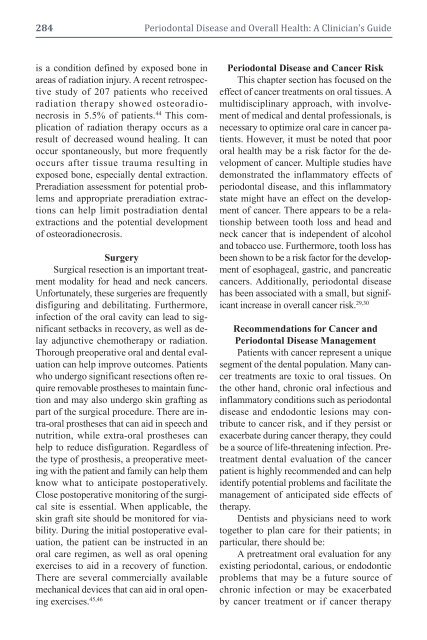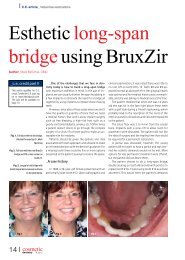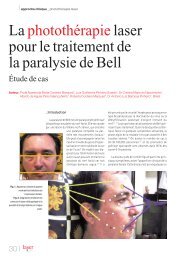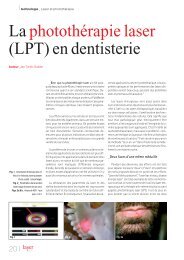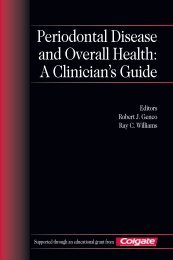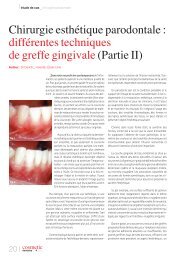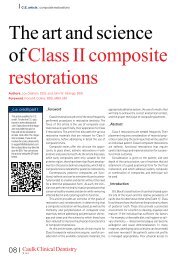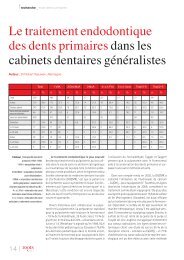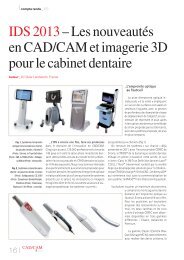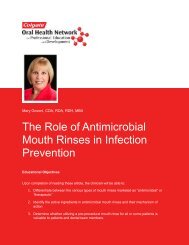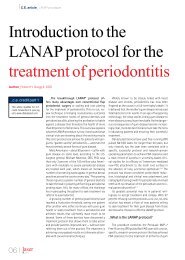Periodontal Disease and Overall Health: A Clinician's Guide
Periodontal Disease and Overall Health: A Clinician's Guide
Periodontal Disease and Overall Health: A Clinician's Guide
Create successful ePaper yourself
Turn your PDF publications into a flip-book with our unique Google optimized e-Paper software.
284 <strong>Periodontal</strong> <strong>Disease</strong> <strong>and</strong> <strong>Overall</strong> <strong>Health</strong>: A <strong>Clinician's</strong> <strong>Guide</strong>is a condition defined by exposed bone inareas of radiation injury. A recent retrospectivestudy of 207 patients who receivedradiation therapy showed osteoradionecrosisin 5.5% of patients. 44 This com -plication of radiation therapy occurs as aresult of decreased wound healing. It canoccur spon taneously, but more frequentlyoccurs after tissue trauma resulting inexposed bone, especially dental extraction.Preradiation assessment for potential problems<strong>and</strong> appropriate preradiation extractionscan help limit postradiation dentalextractions <strong>and</strong> the potential developmentof osteo radio necrosis.SurgerySurgical resection is an important treatmentmodality for head <strong>and</strong> neck cancers.Unfortunately, these surgeries are frequentlydisfiguring <strong>and</strong> debilitating. Furthermore,infection of the oral cavity can lead to significantsetbacks in recovery, as well as delayadjunctive chemotherapy or radiation.Thorough preoperative oral <strong>and</strong> dental evaluationcan help improve outcomes. Patientswho undergo significant resections often requireremovable prostheses to maintain function<strong>and</strong> may also undergo skin grafting aspart of the surgical procedure. There are intra-oralprostheses that can aid in speech <strong>and</strong>nutrition, while extra-oral prostheses canhelp to reduce disfiguration. Regardless ofthe type of prosthesis, a preoperative meetingwith the patient <strong>and</strong> family can help themknow what to anticipate postoperatively.Close postoperative monitoring of the surgicalsite is essential. When applicable, theskin graft site should be monitored for viability.During the initial postoperative evaluation,the patient can be instructed in anoral care regimen, as well as oral openingexercises to aid in a recovery of function.There are several commercially availablemechanical devices that can aid in oral openingexercises. 45,46<strong>Periodontal</strong> <strong>Disease</strong> <strong>and</strong> Cancer RiskThis chapter section has focused on theeffect of cancer treatments on oral tissues. Amultidisciplinary approach, with involvementof medical <strong>and</strong> dental professionals, isnecessary to optimize oral care in cancer patients.However, it must be noted that poororal health may be a risk factor for the developmentof cancer. Multiple studies havedemonstrated the inflammatory effects ofperiodontal disease, <strong>and</strong> this inflammatorystate might have an effect on the developmentof cancer. There appears to be a relationshipbetween tooth loss <strong>and</strong> head <strong>and</strong>neck cancer that is independent of alcohol<strong>and</strong> tobacco use. Furthermore, tooth loss hasbeen shown to be a risk factor for the develop -ment of esophageal, gastric, <strong>and</strong> pancreaticcancers. Additionally, periodontal diseasehas been associated with a small, but significantincrease in overall cancer risk. 29,30Recommendations for Cancer <strong>and</strong><strong>Periodontal</strong> <strong>Disease</strong> ManagementPatients with cancer represent a uniquesegment of the dental population. Many cancertreatments are toxic to oral tissues. Onthe other h<strong>and</strong>, chronic oral infectious <strong>and</strong>inflammatory conditions such as periodontaldisease <strong>and</strong> endodontic lesions may contributeto cancer risk, <strong>and</strong> if they persist orexacerbate during cancer therapy, they couldbe a source of life-threatening infection. Pretreatmentdental evaluation of the cancerpatient is highly recommended <strong>and</strong> can helpidentify potential problems <strong>and</strong> facilitate themanagement of anticipated side effects oftherapy.Dentists <strong>and</strong> physicians need to worktogether to plan care for their patients; inparticular, there should be:A pretreatment oral evaluation for anyexisting periodontal, carious, or endodonticproblems that may be a future source ofchronic infection or may be exacerbatedby cancer treatment or if cancer therapy


